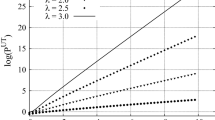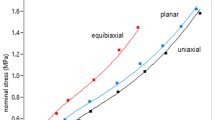Abstract
Hyperelastic models are widely used to describe the mechanical response of rubber. However, purely mechanical models cannot account for changes in the material due to chemical reactions such as those that take place during vulcanization. Here, we present a model developed within a thermodynamic framework accounting for chemical reactions. A mixture theory approach that allows for the existence of multiple species and their interconversion is followed. The existence of a Helmholtz potential and a rate of entropy production function for the mixture as a whole are posited. Following the multiple natural configuration approach, the rate of entropy production is maximized to obtain constitutive equations. The viscoelastic model is then specialized to the elastic case. The model is calibrated using data available in the literature for rubber. A simulation of the stress–strain curve of rubber as vulcanization progresses is presented.
Similar content being viewed by others
References
Abhilash P.M., Kannan K., Varkey B.: Simulation of curing of a slab of rubber. Mater. Sci. Eng. B 168, 237–241 (2010)
Bustamante R., Rajagopal K.R.: A note on plane strain and plane stress problems for a new class of elastic bodies. Math. Mech. Solids 15(2), 229–238 (2010)
Coran A.Y.: Vulcanization. part VI. A model and treatment of scorch delay kinetics. Rubber Chem. Technol. 37, 689–697 (1964)
Ghosh P., Katare S., Patkar P., Caruthers J.M., Venkatasubramanian V., Walker K.A.: Sulphur vulcanization of natural rubber for benzothiazole accelerated formulations: from reaction mechanisms to a rational kinetic model. Rubber Chem. Technol. 76, 592–693 (2003)
Green A.E., Naghdi P.M.: On thermodynamics and the nature of the second law. Proc. R. Soc. Lond. A 357, 253–270 (1977)
Hamed G.R., Zhao J.: Tensile behaviour after oxidative aging of gum and black-filled vulcanizates of SBR and NR. J. Rubber Chem. Technol. 72, 721–730 (1999)
Kannan K., Rajagopal K.R.: A thermodynamic framework for chemically reacting systems. ZAMP 62, 331–363 (2011)
Krishnan J.M., Rajagopal K.R.: A thermodynamic framework for the constitutive modeling of asphalt concrete: theory and applications. ASCE J. Mater. Civil Eng. 16, 155–166 (2004)
Loo C.T.: High temperature vulcanization of elastomers:2. Network structures in conventional sulphenamide–sulphur natural rubber vulcanizates. Polymer 15, 357–365 (1974)
Rajagopal K.R.: On implicit constitutive theories. Appl. Math. 48(4), 279–319 (2003)
Rajagopal K.R.: The elasticity of elasticity. ZAMP 58(2), 309–317 (2007)
Rajagopal K.R., Srinivasa A.R.: Mechanics of the inelastic behavior of materials: part I—theoretical underpinning. Int. J. Plast. 14, 969–995 (1998)
Rajagopal K.R., Srinivasa A.R.: A thermodynamic framework for rate type fluid models. J. Non Newton. Fluid Mech. 88, 207–227 (2000)
Rajagopal K.R., Tao L.: Mechanics of Mixtures. World Scientific Publishing Co Pvt Ltd., Singapore (1995)
Rao I.J., Rajagopal K.R.: A thermodynamic framework for the study of crystallization in polymers. ZAMP 53, 365–406 (2002)
Samohýl I.: Thermodynamics of Irreversible Processes in Fluid Mixtures. Teubner, Leipzig (1987)
Spencer A.J.M., Rivlin R.S.: The theory of matrix polynomials and its application to the mechanics of isotropic continua. Arch. Rat. Mech. Anal. 2, 309–336 (1958)
Author information
Authors and Affiliations
Corresponding author
Rights and permissions
About this article
Cite this article
Kundurthi, S., Mythravaruni, P. & Ravindran, P. Vulcanization and the mechanical response of rubber. Z. Angew. Math. Phys. 66, 1109–1123 (2015). https://doi.org/10.1007/s00033-014-0417-6
Received:
Revised:
Published:
Issue Date:
DOI: https://doi.org/10.1007/s00033-014-0417-6




